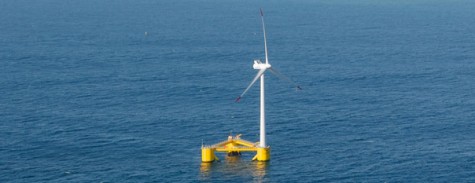Wind turbine technology is rapidly improving. One obvious example: Europe has trounced the US when it comes to putting up conventional shallow water wind farms, having already deployed 53 projects with 3,800 megawatts of capacity. However, a single floating turbine, built by Seattle-based Principle Power and called the WindFloat, is currently anchored off the coast of Portugal and could vault America into a more successful renewable energy future.

Plagued by delays and litigation (think Cape Wind), US offshore wind finally showed signs of life when the Department of the Interior completed its second lease auction off of Virginia, and the nation's first floating wind turbine powered up last spring off the coast of Maine. But momentum surged when Principle Power got a green light to submit plans to site five of their WindFloat turbines off of Coos Bay, Oregon.
This was announced at a recent press conference by Oregon Gov. John Kitzhaber, US Secretary of the Interior Sally Jewell, and Bureau of Ocean Energy Management Director (BOEM) Tommy Beaudreau.
Since offshore wind farms are still one of the most expensive sources of energy, Mr Baudreau cautioned, "It's not going to be economic out of the gate." Adding, according to the Associated Press, "It's important for Oregon to be on the edge of what could be a huge industry in the future."
With this big thumbs up, Principle Power will now prepare a detailed construction and operations plan, which it hopes to have ready by late 2014.
Overcoming natural obstacles
WindFloat's semi-submersible platforms overcome the biggest obstacle that made wind turbines a no-show off Oregon's coast: the steep drop in the continental shelf that makes it impossible to embed conventional turbines in the ocean floor. WindFloat's design would gently rock above the quarter-mile-deep water, attached to pre-laid moorings, scooping up the strong winds blowing off the coast.

To improve efficiency, the turbines would be as tall as a sixty-story building - much larger than land-based counterparts - said Keith Banister, Principle's VP for Business and Governmental Affairs.
Principle's Portugal demonstration project has given the company confidence that it's floating platforms that will remain stable during major storms, added Banister. "It has gone through 50-foot waves and performed through those condition."

Cutting-edge innovations
The project will cost $200 million, having already received $4 million in DOE funding as an advanced demonstration project. But Principle Power is still waiting to reach a power purchase agreement with Oregon utilities.
Cost savings are built directly into the design of the WindFloat, which enables it to be fully assembled onshore and towed 17 miles out to its final location. Savings are significant when compared with monopile supports, which require specialized offshore heavy-lift vessels.
Supported on three floating platforms moored by cables anchored to the sea floor, the turbine towers would rise 600 feet to the highest point of the blade tip. The electricity would be transmitted to shore by underwater cable. With the turbines spaced about a mile a apart, the wind farm would generate 30 megawatts of power by late 2017, enough to power 8,000 homes. Watch this dry-land construction of Principle Power's Portugal turbine.
The mooring system uses conventional chain and polyester lines to minimize cost. Through the use of pre-laid drag embedded anchors, site preparation and impact is minimized.

800 gigawatts of wind energy potential
The DOE's National Renewable Energy Laboratory has estimated that the West Coast has 800 gigawatts of wind energy potential, equal to more than three-fourths of the nation's entire power generation capacity. Further research has found that southern Oregon and Northern California have some of the strongest and most consistent winds.
Studies show that these turbines will produce about 40% of their maximum generating capacity, way above the 20% to low 30% of land-based California wind farms and close to the best wind farms planned for Wyoming with a 45% capacity.


